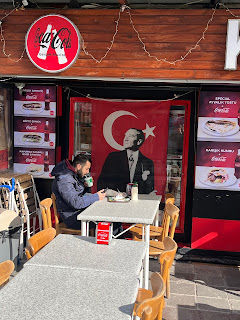For the last three days our group has stayed in the city of Izmir, which lies in the same location as the ancient city of Smyrna.
Izmir is the third largest city in Türkiye (with a population of roughly 4.5 million people, behind Istanbul and Ankara) and is located right on the coast of the Aegean Sea, facing Greece.
Because of Izmir’s direct connection to the sea, it was an important piece of the Roman and Ottoman Empire as a main trading staple. After the conclusion of World War 1- which simultaneously sparked the beginning of the Turkish independence movement- Izmir became a place of Turkish revolution.
Today our group walked around city, and looked at several important statues located in the urban area. The leader of the independence movement, and later the first president of the Republic of Türkiye, Mustafa Kemal Ataturk, is plastered all throughout Izmir.
He’s framed in coffee shops, front row pictures at fashion shops, included in art along the pier, and probably anywhere else you can think of.
This is for many reasons.
First of all, Ataturk is widely considered to be the father of the modern Turkish Republic. He was the leader during the movement for independence and therefore is honored almost as a deity.
At the center of Izmir, there is a prominent statue of Ataturk. He is sculpted on horseback, facing Greece. Many say this is representative of his diplomatic policies toward the Greeks.
This resulted in an event called ‘the swap’. Turks who lived in Greece were ‘traded’ for Greeks who lived in Türkiye on very short notice. Families were given very little time to evacuate their homes and flee the country.
Therefore the statue of Ataturk leading his men into battle faces Greece, proclaiming the Greeks as a common enemy. Or in other words, a foe who need to ‘go back to where they came from’.
This as a whole, is a personification of the strong ethnic divides that Ataturk juiced into the nation at the peak of his powers. Anatolia was a place of cultural confluence, but the events of 1923 changed that for a long period.
However, on another note, the appearance of Ataturk is also a representation of progressive thought within the Turkish Republic.
In 1923, when Türkiye gained its independence as a nation, Ataturk led a movement of westernization throughout the country. For instance, he banned the wearing of the Fez, persuaded Turkish citizens to adapt to modern clothes, and changed the Turkish alphabet from Arabic to Latin script.
Ataturk even granted women many rights within the country in efforts to elevate them to the same status as men. Taking things into context, this was long before countries like the United States would do the same.
He built additional universities for women to attend, and his daughter became the first Turkish female pilot: becoming a role model for young Turkish girls.
As our tour guide Saba says, the closer a city is to the sea, the more liberal it tends to be. This is definitely the case for Izmir.
So, in a way, photos of and sculptures of Ataturk covering the city of Izmir are symbolic of their dedication to progressiveness. This dedication has become especially relevant in the modern day.
Current President Erdogan is leading a movement that some describe as “de-westernization”. This is best exemplified by his conversion of The Hagia Sofia from a museum back into a mosque.
Some see these acts as Erdogan turning his back on the European world and focusing on becoming a larger force in the Islamic world.
In many ways, Izmir’s devotion and idolization of Ataturk shows their pledge to progressive thought, and possible angst against the motives of Erdogan.
Overall, we enjoyed our stay in Izmir, and now look forward to the rest of today flying to Ankara: Türkiye’s capital.
We cannot wait to see what’s in store!















Kathan, I enjoyed your shared insight to the political landscape of Turkey over time. I am glad we don’t have to have pictures of our leaders everywhere! I was intrigued by the early opportunities for women!
ReplyDeletethanks mom
DeleteNice blog post, I felt like I was there with you! Ataturk seems controversial but pretty interesting. the aegan sea is cool too
ReplyDeletethe Aegean is very cool, thanks Big Sis
DeleteInteresting tour and discussion. I appreciate the opportunity to travel with you vicariously. Papa Bear
ReplyDeleteThanks for sharing. Izmir seems like a fascinating place shaped by history, culture, and geography.
ReplyDeleteEnjoyed this latest post to the group blog. Appreciate the historical context blended with the current political situation. I reflected upon the Turkish students and professor I encountered during my college years. Interesting to consider aspects of their lives with a broader knowledge of their culture and history.
ReplyDeleteNice summary of Izmir's
ReplyDeleteroots and place within modern Turkey. Very informative!
Did your guide explain the meaning of “Ataturk”? Dadaji
ReplyDeleteInteresting idea that Saba has that living near water creates a more progressive environment. We know that study abroad engages a global view with more understanding and empathy and those along coastlines would naturally engage with more visitors. The water views, particularly the selfie with Saba and the faculty overlooking the city, are beautiful. --Connie Book
ReplyDelete